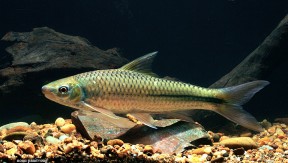Lobocheilos melanotaenia
SynonymsTop ↑
Tylognathus melanotaenia Fowler, 1935; ? Tylognathus quadrilineatus Fowler, 1935; ? Tylognathus davisi Fowler, 1937; ? Tylognathus fowleri Pellegrin & Chevey, 1936; ? Lobocheilus nigrovittatus Smith, 1945
Etymology
Lobocheilos: from the Ancient Greek λοβός (lobós), meaning ‘lobe’, and χείλος (cheílos), meaning ‘lip’, in reference to the prominent rostral cap in this genus.
melanotaenia: from the Ancient Greek μέλας (mélas), meaning ‘black’, and ταινία (tainía), meaning ‘ribbon’, in reference to the black lateral stripe on the posterior portion of the body.
Classification
Order: Cypriniformes Family: Cyprinidae
Distribution
Native to the Mekong River in Laos, Thailand, Cambodia, and Vietnam, the Dong Nai basin in southern Vietnam, and the Chao Phraya and Mae Klong systems in central and western Thailand, respectively.
Type locality is ‘Nam Poo Mountain, Pasak River, Petchabun, Thailand’, corresponding to the Pa Sak River in Phetchabun province, northern Thailand. The Pa Sak is a major tributary within the Chao Phraya drainage basin.
Habitat
This species is considered to be one of the most abundant species in the massive seasonal migrations of cyprinid fishes that occur in the mainstream Mekong river in December to February and May to July.
Otherwise, it has been recorded in rivers and streams of all sizes down to around 2-3 m in width, mostly with moderate to fast flow and rocky substrates.
Maximum Standard Length
150 – 200 mm.
Aquarium SizeTop ↑
An aquarium with base dimensions of 180 ∗ 60 cm or equivalent should be the smallest considered.
Maintenance
A display arranged to resemble a flowing stream or river, with a substrate of variably-sized, water-worn rocks, sand, fine gravel and perhaps some small boulders, is highly recommended. This can be further furnished with driftwood roots or branches and hardy aquatic plants such as Microsorum, Bolbitis, or Anubias spp., which can be grown attached to items of décor.
Most importantly, the water must be clean and well-oxygenated with turnover preferably in excess of 10 times per hour; additional powerheads and airstones can be employed to achieve the desired flow and oxygenation if necessary. Bright lighting will promote development of a biofilm on solid surfaces, upon which the fish will graze.
Water Conditions
Temperature: 20 – 26 °C
pH: 6.0 – 8.0
Hardness: 36 – 215 ppm
Diet
Lobocheilos species are specialised grazers of periphyton, benthic algae, and other organisms which grow attached to rocks and other solid surfaces, and they typically leave visible scrape marks in places where they have been feeding.
They are by no means herbivorous and should be offered meaty foods such as live or frozen chironomid larvae (bloodworm), Tubifex, Artemia, chopped prawn, etc., along with good quality, sinking dried products, at least some of which should contain a significant proportion of vegetable matter such as Spirulina or similar.
Behaviour and CompatibilityTop ↑
Can be aggressive at times, especially when food is added to the aquarium, and will often actively pursue fishes straying into the vicinity.
The most suitable tankmates are active, peaceful cyprinids since they are normally agile enough to avoid such attacks. Slow-moving or long-finned species should be omitted in the majority of circumstances.
It is not particularly tolerant of conspecifics, especially if space is limited, but normally exists in loose aggregations in the wild and should ideally be maintained in a group.
Sexual Dimorphism
Sexually mature females are deeper-bodied than males, while males possess more extensive tuberculation on the head and snout.
Reproduction
Unreported in aquaria. Wild fish undertake seasonal spawning migrations, moving from the lower Mekong and Tonlé Sap system to the middle portion of the Mekong basin in Laos to spawn.
NotesTop ↑
The majority of Lobocheilos species are endemic to the Greater Sunda Islands of Borneo, Sumatra, and Java, and are uncommon in the aquarium trade, but the widespread Indochinese taxa L. melanotaenia and L. rhabdoura are available on a sporadic basis.
L. melanotaenia can be distinguished from L. rhabdoura by the following combination of characters: body relatively deep, depth fits 3.2-3.7 times in SL; mouth relatively narrow, less wide than head; tubercules on snout relatively small; dorsal-fin with a medial dark area; 11-13 predorsal scales; 5+20-25 rakers on anterior side of first gill arch.
Lobocheilos species are considered members of the tribe Labeonini within the putative cyprinid subfamily Cyprininae or simply the subfamily Labeoninae (name varies with author). According to the most recent phylogenetic research, this grouping is further divided into four subtribes; Labeoina, Garraina, Osteochilina, and Semilabeoina (Yang et al., 2012). Among these, it is included in the Osteochilina alongside the genera Epalzeorhynchos, Crossocheilus, Barbichthys, Thynnichthys, Labiobarbus, and Osteochilus, among others.
References
- Fowler, H. W., 1935 - Proceedings of the Academy of Natural Sciences of Philadelphia v. 87: 89-163
Zoological results of the third De Schauensee Siamese Expedition, Part VI - Fishes obtained in 1934. - Freyhof, J., D. V. Serov and T. N. Nguyen, 2000 - Bonner Zoologische Beiträge 49(1-4): 93-99
A preliminary checklist of the freshwater fishes of the River Dong Nai, South Vietnam. - Kottelat, M., 2001 - WHT Publications, Colombo: 1-198
Fishes of Laos. - Kottelat, M., 2013 - Raffles Bulletin of Zoology Supplement 27: 1-663
The fishes of the inland waters of southeast Asia: a catalogue and core bibiography of the fishes known to occur in freshwaters, mangroves and estuaries. - Kottelat, M., 1998 - Ichthyological Exploration of Freshwaters 9(1): 1-128
Fishes of the Nam Theun and Xe Bangfai basins, Laos, with diagnoses of twenty-two new species (Teleostei: Cyprinidae, Balitoridae, Cobitidae, Coiidae and Odontobutidae). - Rainboth, W. J., 1996 - FAO, Rome: 1-265
FAO species identification field guide for fishery purposes. Fishes of the Cambodian Mekong. - Yang, L., M. Arunachalam, T. Sado, B. A. Levin, A. S. Golubtsov, J. Freyhof, J. P. Friel, W-J. Chen, M. V. Hirt, R. Manickam, M. K. Agnew, A. M. Simons, K. Saitoh, M. Miya, R. L. Mayden, and S. He, 2012 - Molecular Phylogenetics and Evolution 65(2): 362-379
Molecular phylogeny of the cyprinid tribe Labeonini (Teleostei: Cypriniformes).




